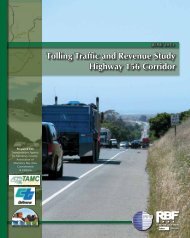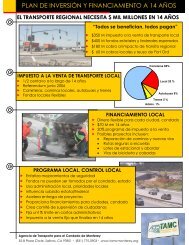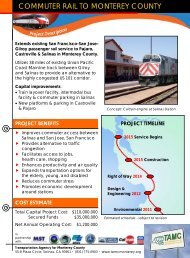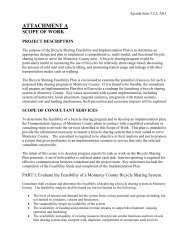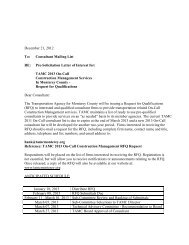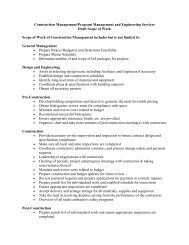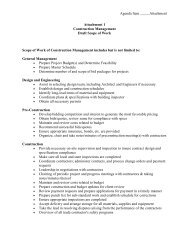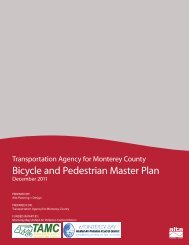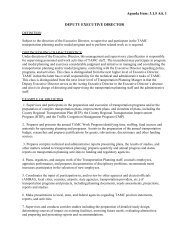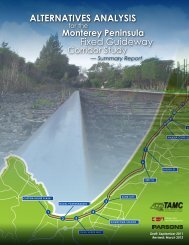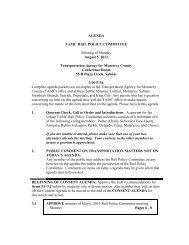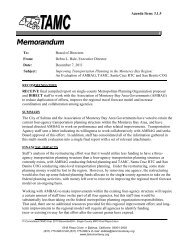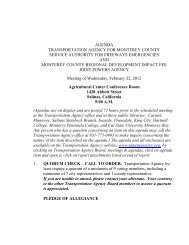Commuter Rail Extension Alternatives Analysis - Transportation ...
Commuter Rail Extension Alternatives Analysis - Transportation ...
Commuter Rail Extension Alternatives Analysis - Transportation ...
Create successful ePaper yourself
Turn your PDF publications into a flip-book with our unique Google optimized e-Paper software.
CALTRAIN EXTENSION TO MONTEREY COUNTYALTERNATIVES ANALYSISSOCIAL PERFORMANCE OF THE CALTRAIN EXTENSION AND EXPRESSBUS ALTERNATIVESThe social or societal performance evaluation of the alternatives is intended to provide additionalinformation for decision making, other than economic performance. Included in this section are quantitativeand/or qualitative measurements of criteria often used for transit investment decision making.Daily Transit RidersTransit ridership for the Caltrain <strong>Extension</strong> and Express Bus alternatives is a key ingredient ofdetermining both cost effectiveness and societal feasibility, which includes very limited transit servicebetween Monterey County and the San Francisco Bay Area, is assumed to carry negligible ridership(less than 50 riders per day) insofar as determining the beneficial impacts of Caltrain <strong>Extension</strong> orExpress Bus investments. Hence, virtually all ridership attracted to the Caltrain <strong>Extension</strong> andExpress Bus alternatives is considered to be “new” riders.The estimate of Caltrain <strong>Extension</strong>/Express Bus Alternative ridership is assumed to be equal, asreported earlier. Annual patrons along with annual passenger miles are reported in Table 8-35 forreference. The table indicates that 524,280 passengers are anticipated as of year 2010; increasing to1,001,130 by 2030. Expressed on a daily basis, these equate to 2,056 riders per weekday in 2010(1,028 each direction), and 3,926 riders per weekday in 2030 (1,963 each direction).Table 8-352010 and 2030 Annual Passengers and Annual Passenger Miles2010 2030Egress/Access Pajaro Castroville Salinas Total Pajaro Castroville Salinas TotalAnnual PassengersSanta Clara–Mid 48,960 10,200 89,250 148,410 85,170 25,500 173,400 284,070Santa Clara–North 106,590 22,440 193,290 322,320 184,620 55,590 374,850 615,060San Mateo 12,240 2,550 21,930 36,720 20,910 6,120 42,840 69,870San Francisco 5,610 1,020 10,200 16,830 9,690 3,060 19,380 32,130173,400 36,210 314,670 524,280 300,390 90,270 610,470 1,001,130Annual Passenger MilesSanta Clara–Mid 2,428,416 601,800 6,015,450 9,045,666 4,224,432 1,504,500 11,687,160 17,416,092Santa Clara–North 6,960,327 1,676,268 16,062,399 24,698,994 12,055,686 4,152,573 31,150,035 47,358,294San Mateo 973,080 226,695 2,133,789 3,333,564 1,662,345 544,068 4,168,332 6,374,745San Francisco 544,731 108,630 1,171,980 1,825,341 940,899 325,890 2,226,762 3,493,55110,906,554 2,613,393 25,383,618 38,903,565 18,883,362 6,527,031 49,232,289 74,642,682These ridership levels are modest by comparison with many “new starts” proposals. When expressedas equivalent riders, based on passenger miles traveled, these ridership levels are impressive.Listed in Table 8-36 are statistics culled from the 2004 National Transit Database regarding averagetrip lengths of transit riders. The table also lists rider equivalents for the Caltrain <strong>Extension</strong> or ExpressBus alternatives.Interpretation of the table is as follows. The average transit rider trip length for the proposed MontereyCounty service is 74.2 one-way miles. Compared to the national commuter rail average of 23.5 miles,the Monterey County service will attract trips which are 3.16 times as long on average. The 2,056parsons CHAPTER 8: EVALUATION OF ALTERNATIVES 199



